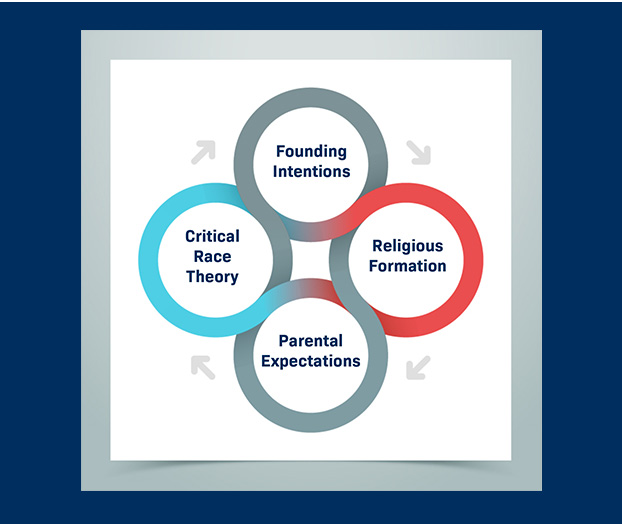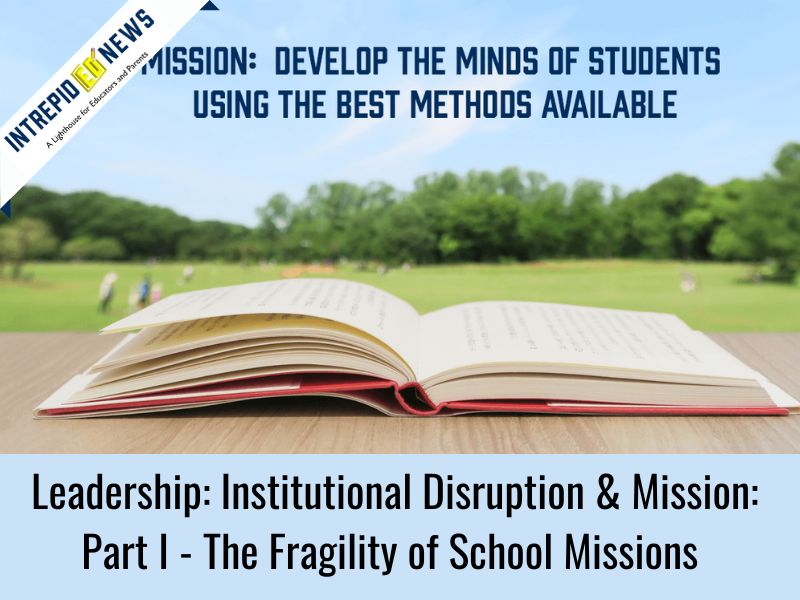Leadership: Institutional Disruption & Mission: Part I – The Fragility of School Missions
This article is republished with permission from IntrepidEd News
Ray Ravaglia
This is the first in a series of articles written by either Ray Ravaglia or Sanje Ratnavale in which topics of disruption and mission will be explored in the broader context of how schools should change when they find themselves pulled in directions that may be misaligned with their missions.
While independent schools like to think of themselves as timeless and eternal, the world around them is constantly shifting. With these shifts comes the need for reflection and reexamination particularly when changes in technologies, priorities or societal concerns suggest that old practices should give way to new ones. In the past 18 months, faced with a global pandemic and social unrest, schools have had both their manner of operation and reason for being shaken to the firmament.
This process of re-examination and reflection is necessary because they have a tendency to fall in love with their current practices, losing sight of why they were introduced. As when circumstances change they can spend more time thinking about how the changes impact the practices themselves rather than focusing on the more fundamental question about the continued relevance of the mission.
A simple example to illustrate this point is the Harkness Table. Created to facilitate a collaborative approach to problem-solving and learning, the Harkness Table is symbolic of the best of independent schools, small and intimate classrooms where students assume responsibility for their own learning. When one calls the Harkness Table to mind one envisions a large oval oaken structure first designed and manufactured in 1930. Over time, institutions have had to evaluate the Harkness implementation against the underlying goal. Asking whether this is the best way to teach or learn for the target students is the right type of analysis. Asking whether the Harkness table can be made of metal or if desks might be rearranged to emulate a Harkness oval is a failure to distinguish the underlying practice from its implementation. This is not to say that all questions of implementation are trivial. A question like whether one could implement the Harkness method digitally with video conferencing is both timely and has profound implications. Certainly, there are a variety of delivery configurations that would support the Harkness method of instruction. There is nothing essential in the method that requires wood, let alone physical proximity. But no delivery configuration entails a specific methodology or pedagogy. Those strategies are tightly connected to mission, while the table or delivery itself has nothing to do with mission. It is simply the way in which the mission has been historically pursued.
There are other times when one decides to reinterpret the mission of the school in light of one’s own perception of changed circumstances. A school founded to “develop the minds of students using the best methods available” may have an open-ended mission that makes it possible, or even requires, weighing each new development in methodology or technology. A school founded to deliver an education steeped in the method of shared inquiry of classic texts would be seriously out of line with its mission to adopt a type of education based on lectures and content examinations.

While these examples are simple, they illustrate the type of considerations present these days at the intersection of eternal verities (e.g. religious formation), contemporary views (e.g. critical race theory), parental expectations, and founding intentions. Underlying these considerations are more fundamental questions about whether a mission should be timeless, like an eternal truth, or transient, rooted in a cultural moment. Likewise come questions about whether the classical trappings of classical education — oaken tables and grassy fields — or the more modern equivalents — maker spaces and negative pressure practice domes — are essential elements of a mission-driven pedagogy or are they marketing tools, evoking certain emotions and providing certain visuals?
There is one question that all schools and institutions should think long and hard about: What can we do to ensure that we remain relevant while also remaining true to our core purpose? As operating businesses dependent on donation and tuition, schools do not have the luxury of ignoring relevance. Moreover, failure to answer this question satisfactorily will provoke a more critical question that no school wants to think about, namely What should happen to our institutions when they cease to become relevant?
To answer the former question, let us start first by asking, how do mission-driven institutions such as schools cease to be relevant to their surrounding societies? Irrelevance can come about in one of two ways. It may be that the mission is no longer applicable or it may be that the institution is no longer able to execute the mission effectively due to changed circumstances.
Take a school that seeks, like many independent schools, as part of their mission the formation of the character of a particular group of students. What if society at large starts to devalue mutable character traits focusing instead on immutable characteristics (such as race), effectively diminishing the possibility of the meaningful formation that was the school’s original mission? Should the school then shift its focus to what society now values, for example moving from preparing students for service to preparing students to carry the yoke of collective guilt? Conversely, if the school was created to serve a specific genus of students (such as those of one gender), and society at large starts to define these characteristics defining the genus as fluid, what becomes of the core mission? More exaggeratedly, an independent school in Berlin in the 1930s whose mission might have been to advance a particular conception of the ideal man might find itself in need of a very different mission 10 years later.
What then is a school to do? How can an institution remain relevant? Atlantic Philanthropies founder Chuck Feeney provided one model for preserving institutional relevance: by spending out its endowment during his lifetime and then winding down the foundation. Should school missions, if not schools themselves,,come with an expiration date?
The more hopeful answer comes in two parts. First of all, understand the questions that your mission is supposed to answer. Without knowing the questions, you cannot know if you are being successful in the mission. Schools have tended to rely on continued enrollment and financial support from alumni to be the ultimate measure of their success, but what if these are poor indicators? And as lagging indicators too, because during that process of becoming irrelevant, their constituencies have few other choices: so like the school itself, they fall back on what is familiar even though increasingly flawed? Finding out late will make the necessary pivot all the more difficult for mission control.
The second part is to develop a conception of the mission that mixes a big picture vision with an understanding that every so often we must come together again to review what mission best allows us to achieve that vision. Some elements must be fixed. Without it there is no identity. Some elements must be flexible. Without that there is too much rigidity and irrelevance is inevitable.
As to how to get these answers right — that is a question for future discussion.


















Add comment